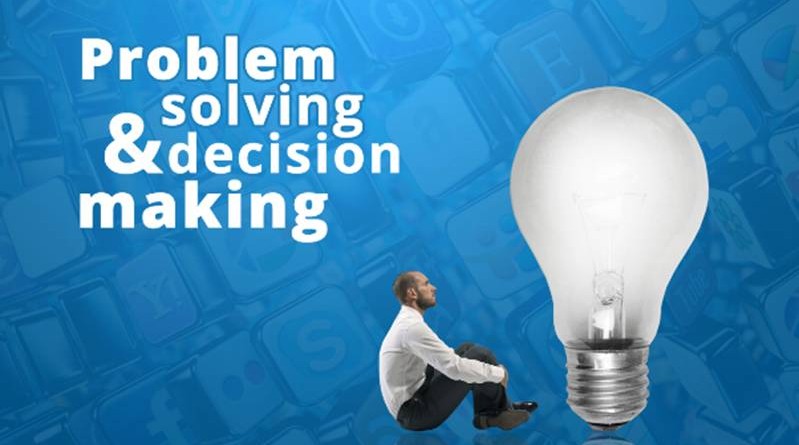Guidelines to Problem Solving and Decision Making
From the managementhelp.org
Much of what people do is solve problems and make decisions. Often, they are “under the gun”, stressed and very short for time. Consequently, when they encounter a new problem or decision they must make, they react with a decision that seemed to work before. It’s easy with this approach to get stuck in a circle of solving the same problem over and over again. Therefore, it’s often useful to get used to an organized approach to problem solving and decision making. Not all problems can be solved and decisions made by the following, rather rational approach. However, the following basic guidelines will get you started. Don’t be intimidated by the length of the list of guidelines. After you’ve practiced them a few times, they’ll become second nature to you — enough that you can deepen and enrich them to suit your own needs and nature.
(Note that it might be more your nature to view a “problem” as an “opportunity”. Therefore, you might substitute “problem” for “opportunity” in the following guidelines.)
- Define the problem
This is often where people struggle. They react to what they think the problem is. Instead, seek to understand more about why you think there’s a problem.
Define the problem: (with input from yourself and others). Ask yourself and others, the following questions:
- What can you see that causes you to think there’s a problem?
- Where is it happening?
- How is it happening?
- When is it happening?
- With whom is it happening? (HINT: Don’t jump to “Who is causing the problem?” When we’re stressed, blaming is often one of our first reactions. To be an effective manager, you need to address issues more than people.)
- Why is it happening?
- Write down a five-sentence description of the problem in terms of “The following should be happening, but isn’t …” or “The following is happening and should be: …” As much as possible, be specific in your description, including what is happening, where, how, with whom and why. (It may be helpful at this point to use a variety of research methods.
Defining complex problems:
If the problem still seems overwhelming, break it down by repeating steps 1-7 until you have descriptions of several related problems.
Verifying your understanding of the problems:
It helps a great deal to verify your problem analysis for conferring with a peer or someone else.
Prioritize the problems:
If you discover that you are looking at several related problems, then prioritize which ones you should address first.
Note the difference between “important” and “urgent” problems. Often, what we consider to be important problems to consider are really just urgent problems. Important problems deserve more attention. For example, if you’re continually answering “urgent” phone calls, then you’ve probably got a more “important” problem and that’s to design a system that screens and prioritizes your phone calls.
Understand your role in the problem:
Your role in the problem can greatly influence how you perceive the role of others. For example, if you’re very stressed out, it’ll probably look like others are, too, or, you may resort too quickly to blaming and reprimanding others. Or, you are feel very guilty about your role in the problem, you may ignore the accountabilities of others.
- Look at potential causes for the problem
- It’s amazing how much you don’t know about what you don’t know. Therefore, in this phase, it’s critical to get input from other people who notice the problem and who are effected by it.
- It’s often useful to collect input from other individuals one at a time (at least at first). Otherwise, people tend to be inhibited about offering their impressions of the real causes of problems.
- Write down what your opinions and what you’ve heard from others.
- Regarding what you think might be performance problems associated with an employee, it’s often useful to seek advice from a peer or your supervisor in order to verify your impression of the problem.
- Write down a description of the cause of the problem and in terms of what is happening, where, when, how, with whom and why.
- Identify alternatives for approaches to resolve the problem
At this point, it’s useful to keep others involved (unless you’re facing a personal and/or employee performance problem). Brainstorm for solutions to the problem. Very simply put, brainstorming is collecting as many ideas as possible, then screening them to find the best idea. It’s critical when collecting the ideas to not pass any judgment on the ideas — just write them down as you hear them. (A wonderful set of skills used to identify the underlying cause of issues is Systems Thinking.)
- Select an approach to resolve the problem
- When selecting the best approach, consider:
- Which approach is the most likely to solve the problem for the long term?
- Which approach is the most realistic to accomplish for now? Do you have the resources? Are they affordable? Do you have enough time to implement the approach?
- What is the extent of risk associated with each alternative?
(The nature of this step, in particular, in the problem solving process is why problem solving and decision making are highly integrated.)
- Plan the implementation of the best alternative (this is your action plan)
- Carefully consider “What will the situation look like when the problem is solved?”
- What steps should be taken to implement the best alternative to solving the problem? What systems or processes should be changed in your organization, for example, a new policy or procedure? Don’t resort to solutions where someone is “just going to try harder”.
- How will you know if the steps are being followed or not? (these are your indicators of the success of your plan)
- What resources will you need in terms of people, money and facilities?
- How much time will you need to implement the solution? Write a schedule that includes the start and stop times, and when you expect to see certain indicators of success.
- Who will primarily be responsible for ensuring implementation of the plan?
- Write down the answers to the above questions and consider this as your action plan.
- Communicate the plan to those who will involved in implementing it and, at least, to your immediate supervisor.
(An important aspect of this step in the problem-solving process is continually observation and feedback.)
- Monitor implementation of the plan
Monitor the indicators of success:
- Are you seeing what you would expect from the indicators?
- Will the plan be done according to schedule?
- If the plan is not being followed as expected, then consider: Was the plan realistic? Are there sufficient resources to accomplish the plan on schedule? Should more priority be placed on various aspects of the plan? Should the plan be changed?
- Verify if the problem has been resolved or not
One of the best ways to verify if a problem has been solved or not is to resume normal operations in the organization. Still, you should consider:
- What changes should be made to avoid this type of problem in the future? Consider changes to policies and procedures, training, etc.
- Lastly, consider “What did you learn from this problem solving?” Consider new knowledge, understanding and/or skills.
- Consider writing a brief memo that highlights the success of the problem solving effort, and what you learned as a result. Share it with your supervisor, peers and subordinates.
Rational Versus Organic Approach to Problem Solving
Rational
A person with this preference often prefers using a comprehensive and logical approach similar to the guidelines in the above section. For example, the rational approach, described below, is often used when addressing large, complex matters in strategic planning.
- Define the problem.
- Examine all potential causes for the problem.
- Identify all alternatives to resolve the problem.
- Carefully select an alternative.
- Develop an orderly implementation plan to implement that best alternative.
- Carefully monitor implementation of the plan.
- Verify if the problem has been resolved or not.
A major advantage of this approach is that it gives a strong sense of order in an otherwise chaotic situation and provides a common frame of reference from which people can communicate in the situation. A major disadvantage of this approach is that it can take a long time to finish. Some people might argue, too, that the world is much too chaotic for the rational approach to be useful.
Organic
Some people assert that the dynamics of organizations and people are not nearly so mechanistic as to be improved by solving one problem after another. Often, the quality of an organization or life comes from how one handles being “on the road” itself, rather than the “arriving at the destination.” The quality comes from the ongoing process of trying, rather than from having fixed a lot of problems. For many people it is an approach to organizational consulting. The following quote is often used when explaining the organic (or holistic) approach to problem solving.
“All the greatest and most important problems in life are fundamentally insoluble … They can never be solved, but only outgrown. This “outgrowing” proves on further investigation to require a new level of consciousness. Some higher or wider interest appeared on the horizon and through this broadening of outlook, the insoluble lost its urgency. It was not solved logically in its own terms, but faded when confronted with a new and stronger life urge.”
From Jung, Carl, Psychological Types (Pantheon Books, 1923)
A major advantage of the organic approach is that it is highly adaptable to understanding and explaining the chaotic changes that occur in projects and everyday life. It also suits the nature of people who shun linear and mechanistic approaches to projects. The major disadvantage is that the approach often provides no clear frame of reference around which people can communicate, feel comfortable and measure progress toward solutions to problems.
Additional Guidelines for Problem Solving and Decision Making
Recommended Articles
Ten Tips for Beefing Up Your Problem Solving Tool Box
Problem Solving Techniques (extensive overview of various approaches)
Key Questions to Ask Before Selecting a Solution to a Business Problem
Five Steps to a Strategic Plan
Additional Articles
Problem-solving and Decision-Making:
Top 5 Tips to Improve Concentration
Problem Solving and Decision Making – 12 Great Tips!
Powerful Problem Solving
Creative Problem-Solving
Leadership Styles and Problem Solving (focus on creativity)
Problem Solving
Forget About Causes, Focus on Solutions
Coaching Tip: Four Question Method for Proactive Problem Solving
Coaching Tip — How to Bust Paralysis by Analysis
Appreciative Inquiry
Powerful Problem-Solving
Guidelines for Selecting An Appropriate Problem Solving Approach
Factors to Consider in Figuring Out What to Do About A Problem
A Case for Reengineering the Problem Solving Process (somewhat advanced)
Courseware on Problemistics (The art & craft of problem dealing)
Adapt your leadership style
Need to Cut Through Complexity and Just Get Things Done?
Organic Approach to Problem Solving
Make Good Decisions, Avoid Bad Consequences
Priority Management: Are You Doing the Right Things?
General Guidelines for Decision Making
6 Steps to Better Decision Making
Managerial Decision Making and the Decision Process
Decision Making Tips
How We Sometimes Fool Ourselves When Making Decisions (traps we can fall into)
More of Most Common Decision-Making Mistakes (more traps we can fall into)
When Your Organization’s Decisions are in the Hands of Devils
Flawed Decision-making is Dangerous
Problem-solving and Decision-Making:
Five Tips for Making Better Decisions
Study Says People Make Better Decisions With a Full Bladder
Making Effective Workplace Decisions
What Everyone Should Know About Decision Making
Various Tools and Methods for Problem Solving and Decision Making
(Many people would agree that the following methods and tools are also for decision-making.)
Consensus Decision Making
Cost Benefit Analysis (for deciding based on costs)
Kurt Lewin Change Model
De Bono Hats (for looking at a situation from many perspectives
Decision Trees (for clarifying and depicting which alternative are derived from which)
Delphi Decision Making (to collect the views of experts and distill expert-based solutions)
Dialectic Decision Making (rigorous action planning via examining opposite points of view)
Fishbone Diagram — 5 Steps to build Fishbone Diagram
Fishbowls (for groups to learn by watching modeled behaviors)
Force-Field Analysis (for identifying opposing forces)
Grid Analysis (for choosing among many choices)
Pareto Principle (for finding the options that will make the most difference — (20/80 rule”)
Polarity Map (for “solving” seemingly unsolvable contradictions)
Rational Decision Making
Storyboarding (for creative group decision making)
SWOT Analysis (to analyze from strengths, weaknesses, opportunities and threats)
Voting
Work Breakdown Structure (for organizing and relating many details)
General Resources for Problem Solving and Decision Making
list of various tools
problem solving resources
long list of tools
Group Decision Making Tool Kit
Mindtools
Decision Making Tools
Decision-making software: tools and tips
Decision Theory
Appreciative Inquiry
Creativity and Innovation
Decision Making
Group Decision Making and Problem Solving
Inquiry and Reflection
Mental Models (scan down to “Mental Models”)
Planning
Questioning
Research Methods
Reframing
Systems Thinking
http://managementhelp.org/personalproductivity/problem-solving.htm




